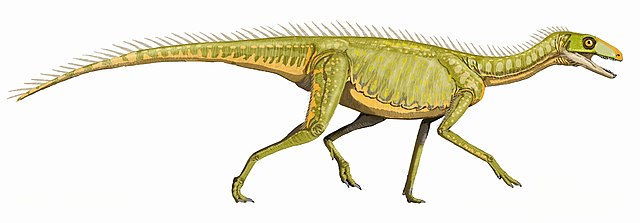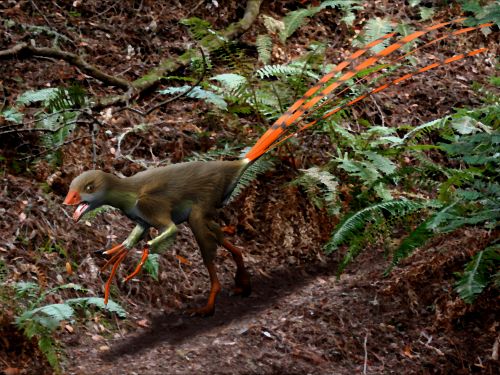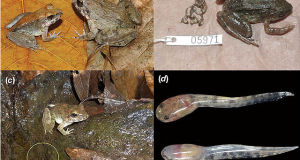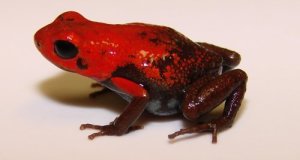Recent studies of a creature known as Nyasasaurus parringtoni indicate that dinosaurs may have appeared over 240 million years ago – 10-15 million years earlier than was previously believed. Its fossils, unearthed in Tanzania, also shed light on where dinosaurs first arose and how they spread to new environments. I’ve also summarized some other recent paleontological surprises concerning the oldest dinosaur nest, dinosaur flea, bird, and organic molecule.
Dinosaur or Silesaur?
Nyasasaurus parringtoni lived in the Mid-Triassic period, alongside dinosaur-like reptiles known as Silesaurids (please see drawing). The dating of its fossils to this period is significant, because true dinosaurs were likely very rare at the time.
Some paleontologists believe that Nyasasaurus is a Silesaurid rather than a dinosaur. However, its upper arm bone bears a bony crest that held the shoulder muscles in place. Known as the deltopectorus crest, this structure is found in all other dinosaurs, but not in Silesaurids.
Dinosaur Origins
The Nyasasaurus fossils were originally found in the 1930’s, but their significance was not apparent until recently. Their collection site (Tanzania) lends strength to the theory that dinosaurs first made their appearance in Pangaea, the ancient southern land mass that existed before the continents began to break away from one another.
Nyasasaurus was likely 6.5 – 10 feet long, but we do not known how it moved about or what it fed upon.
Prior to the discovery of Nyasasaurus, the oldest known dinosaurs were small South American carnivores…but they are a mere 225-230 million years of age!
Oldest Dinosaur Nest
On my frequent visits to the American Museum of Natural History, I never fail to visit the amazing fossil of a small dinosaur on its nest, uncovered some time ago in China. In January of 2012, a Proceedings of the National Academy of Sciences article described dinosaur nests that are 100 million years older than the famous nest exhibited at the AMNH (please see artist’s recreation).
Discovered in South Africa’s Golden Gate Highlands National Park, the nests belonged to a herbivorous dinosaur, Massosponylus carinatus. They have been dated to the Jurassic Period, 190 million years ago.
The Oldest Blood-Sucking Parasite
Today’s fleas, although averaging a mere 0.1 inches in length, are very efficient parasites that cause their hosts a great deal of discomfort. But they pale in comparison to the nearly 1 inch-long ancient monsters unearthed in China. These fleas, which lived during the Mid-Jurassic and Early Cretaceous Periods, had huge mouthparts that could likely pierce dinosaur skin.
Studies of preserved fleas have helped us to understand insect evolution. The Chinese dinosaur fleas are believed to have evolved from scorpion flies, which fed by sucking plant sap. Unlike modern fleas, they crawled rather than jumped.
The Oldest Bird
Fossils of the creature known as Archaeopteryx came to light just 2 years after Charles Darwin published On the Origin of Species. Possessing both reptilian and bird-like characteristics, Archaeopteryx seemed to validate Darwin’s theory of evolution. But on the 150th anniversary of its discovery (September, 2012), an article in the journal Nature identified Archaeopteryx as a feathered dinosaur rather than a true bird.
This finding was based on the work of paleontologists from the Chinese Academy of Sciences, who discovered a 4-winged descendant of Archaeopteryx. This creature, clearly a dinosaur, helped put to rest the theory that Archaeopteryx was an early bird. With Archaeopteryx out of the picture, the oldest known birds are Epidexipteryx (please see artist’s re-creation) and Epidentrosaurus, 160 million-year-old residents of modern day Inner Mongolia.
The Oldest of the Old
The oldest known organic molecule was found in the fossil of a Crinoid, a creature that pre-dated the dinosaurs by millions of years. Ocean-dwelling Crinoids, plant-like animals resembling modern-day Sea Lilies, lived in Ohio, Indiana and Iowa some 350 million years ago.
According to an article in the current (March, 2013) issue of Geology, intact Quinone cells have been found in Crinoid fossils. Quinones, which are present in today’s Sea Lilies, likely functioned as toxins or pigments. Unfortunately, no DNA was recovered.
 That Reptile Blog – Reptile, Amphibian and Exotic Pet Care and Information
That Reptile Blog – Reptile, Amphibian and Exotic Pet Care and Information





It is interesting to have found evidence of such ancient creatures
I thought it was amazing as well, glad you enjoyed, Best, Frank